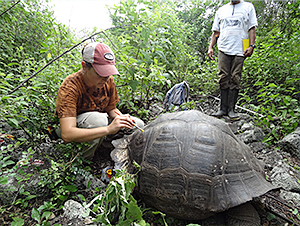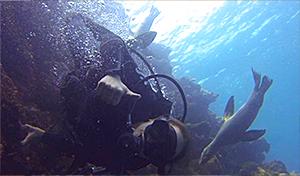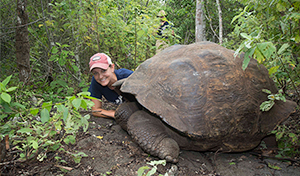


Traveling to the Galapagos Islands to study the health of wild giant tortoises this summer required a long planning process to say the least, but it was absolutely the most incredible way I could have spent my last summer of veterinary school. I originally began organizing ideas to travel to the Galapagos after meeting a veterinarian for the Charles Darwin Foundation (CDF) at a conference in San Francisco. I was later accepted as an international volunteer for the Charles Darwin Foundation and the UC Davis STAR Program with a project comparing different methods of counting white blood cells in wild Galapagos tortoises. While stationed at the CDF, I worked for the Galapagos Tortoise Movement Ecology Programme in collaboration with the Saint Louis Zoo Institute for Conservation Medicine and the University of Florida College of Veterinary Medicine. The Programme aims to assist in the conservation of the threatened Galapagos tortoises by studying their migration dynamics, ecology, and health.
After spending three days in Gainesville, Florida training in reptile hematology with a wildlife clinical pathologist, I flew to Ecuador and then Santa Cruz Island, Galapagos, where I lived at the CDF research station for seven weeks. I arrived a week before the “tortoise team”, from Saint Louis, which allowed me to settle in, practice giant tortoise hematology, familiarize myself with the town of Puerto Ayora and island of Santa Cruz, practice my Spanish speaking skills, and of course, scuba dive! Once the team arrived, it was full steam ahead with some amazing field and laboratory work!
Each day in the field, we spent approximately 8-9 hours hiking a distance of about 16 kilometers in thick, muddy, cactus-filled forests tracking wild tortoises. Local Galapagueñan biologists, who knew the island like the back of their hand, led us through the terrain. Whenever we found a female tortoise (because males were too big to work with), we would perform a complete health assessment. This included a physical exam, blood and fecal sample collection, morphometric data collection (length, width, weight), and an ultrasound exam to assess reproductive status by identifying the presence of follicles or eggs. On a good day we would collect samples from about six individuals. Some tortoises on the island were equipped with GPS tags, which kept track of their migratory routes. We wanted to find these valuable individuals in order to obtain their health data and compare those tortoises that migrate to those that do not. However, despite the island being relatively small, and the tortoises being relatively enormous, locating some of them was like looking for a needle in a … cactus forest! Thus, we spent a lot of time tracking individuals off the beaten path with a VHF transmitter.
Each day after a field day was spent in the laboratory analyzing our blood samples. We collected data including packed cell volume, total protein, clinical chemistry, leukocyte count via three methods (my STAR project), and a leukocyte differential. I spent hours upon hours differentiating tortoise blood cells under the microscope, which was no easy task, but it allowed me to develop skills and a passion for reptile hematology. I also helped teach our local biologists, in Spanish, how to run all of the blood work. As a beginner in Spanish, this was definitely a challenge!
Apart from the work, living in the Galapagos and assimilating into a town and family of other students and scientists from across the globe was an experience that I will cherish for life. The wildlife was unreal: on land, in air, and underwater. And the people were just as wonderful.
Needless to say, I learned more this summer than I thought possible—from speaking Spanish while immersing into the culture of the Galapagos, to drawing blood from tortoises and differentiating millions of blood cells. Problem solving in the field became a daily activity, and maintaining a positive attitude and a sense of humor in light of difficulties and unexpected curveballs is something I learned from my mentors this summer that I hope to take with me throughout the rest of my career. Hopefully, one day I will return to my research office of the Galapagos jungle!
